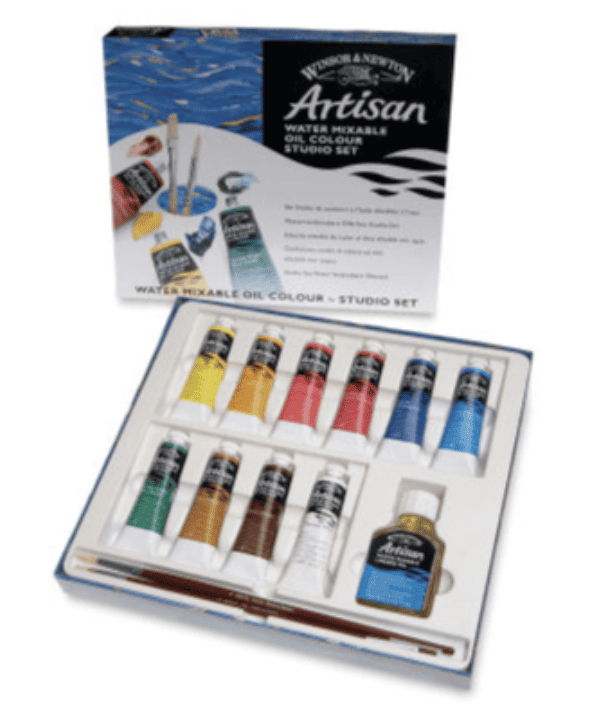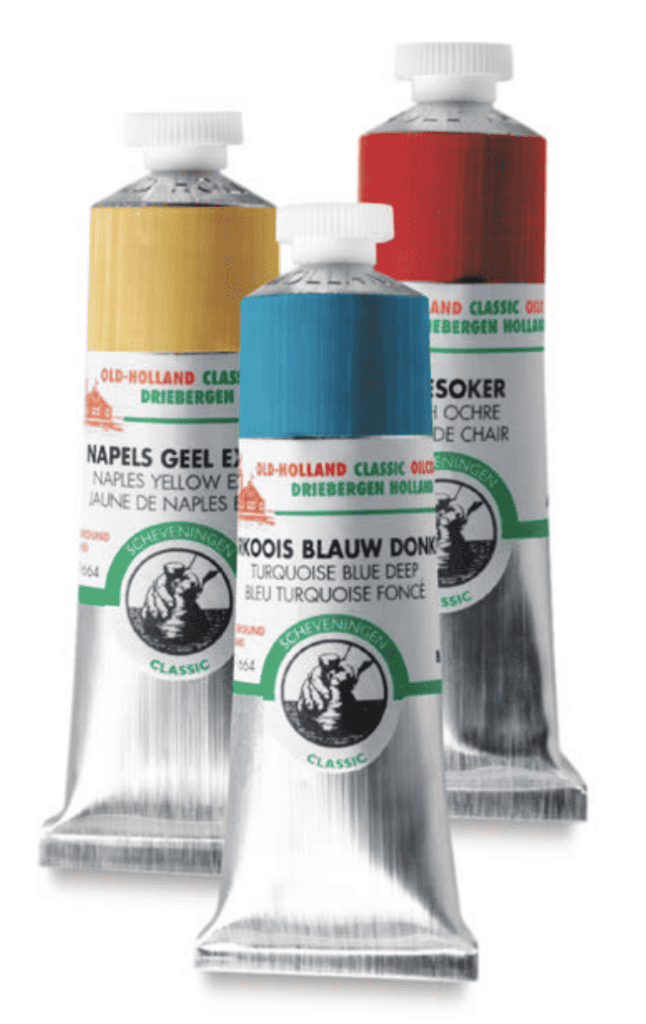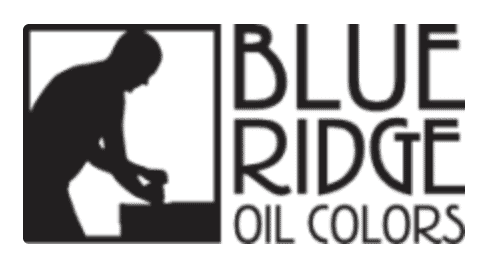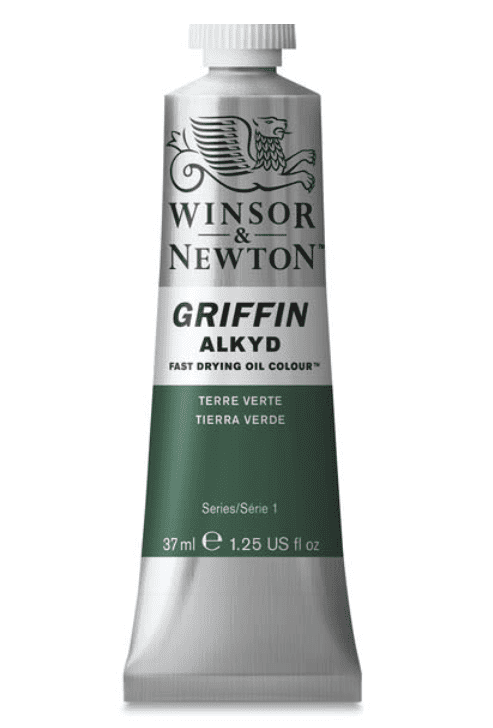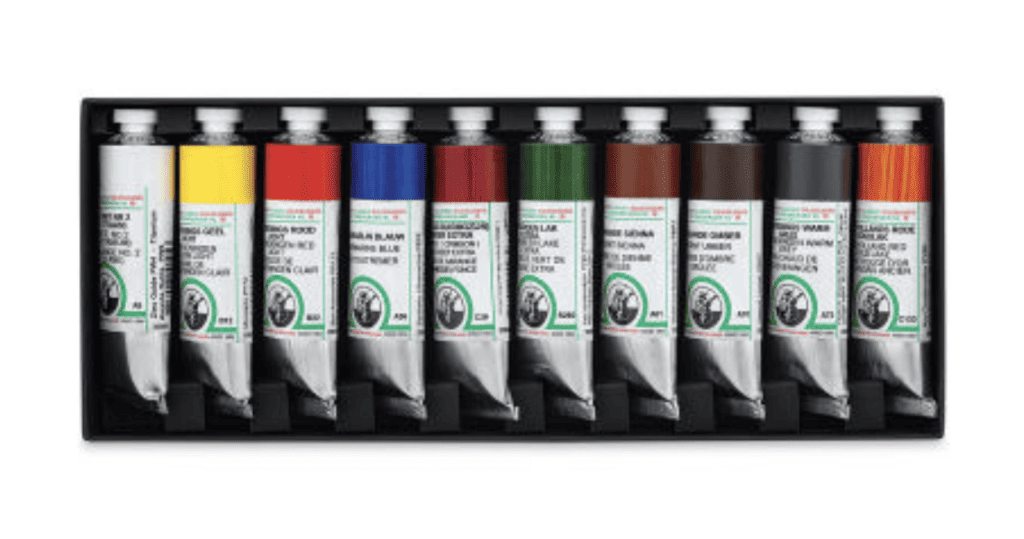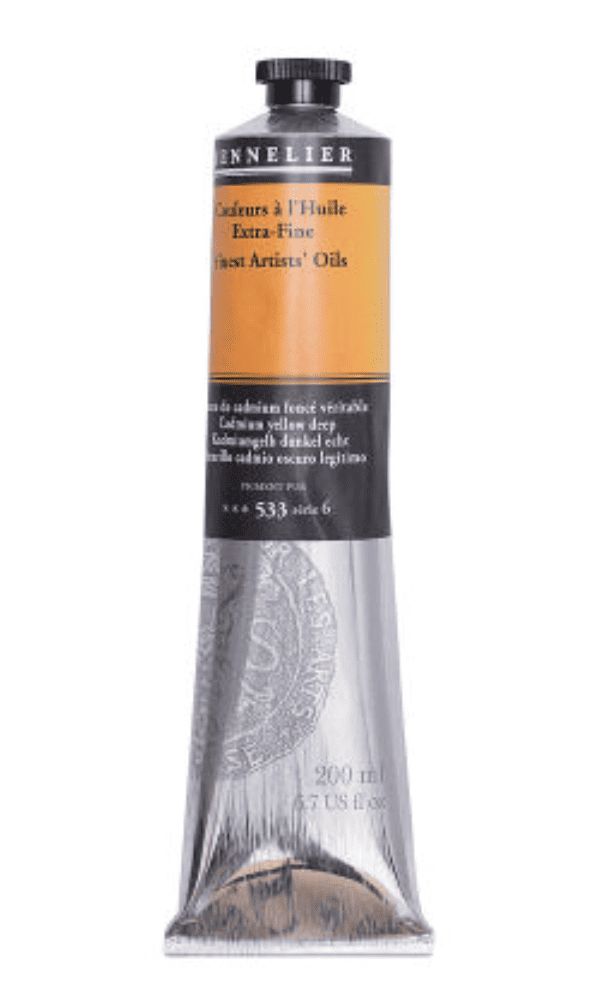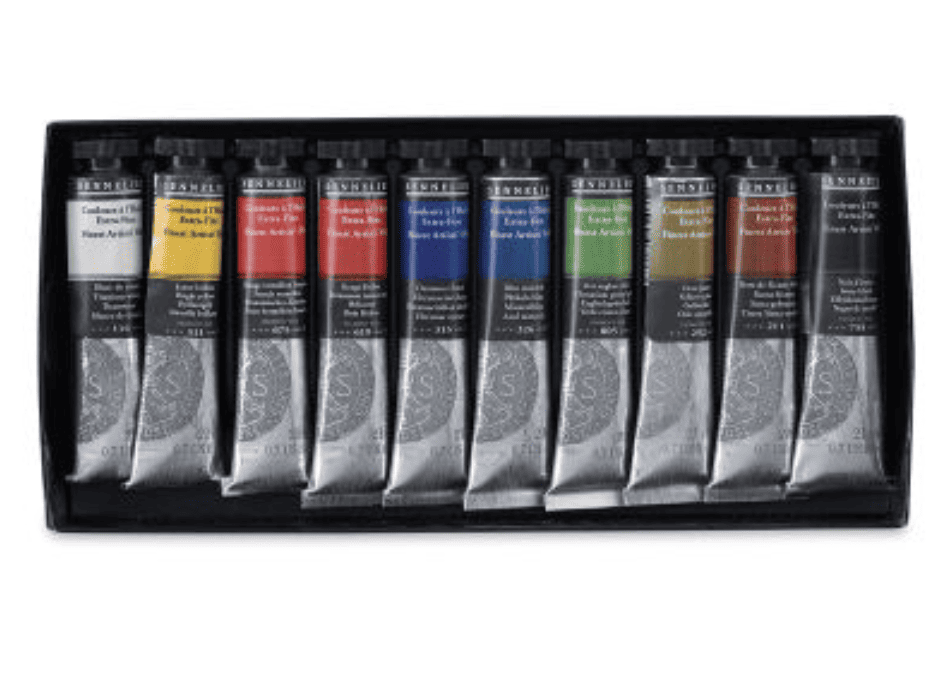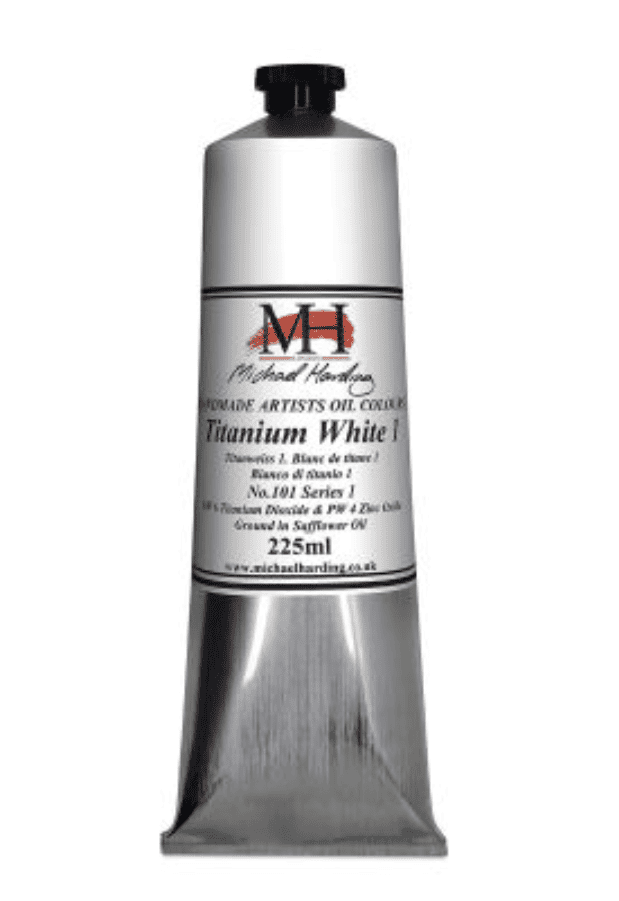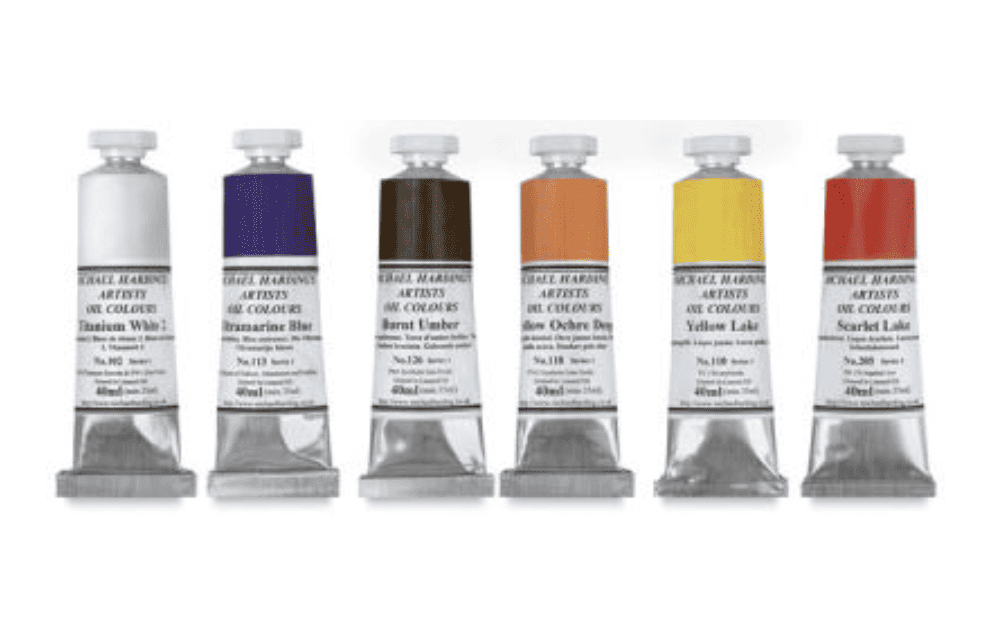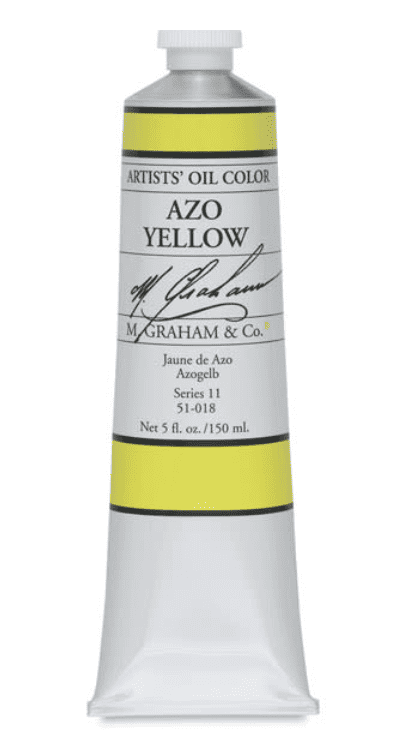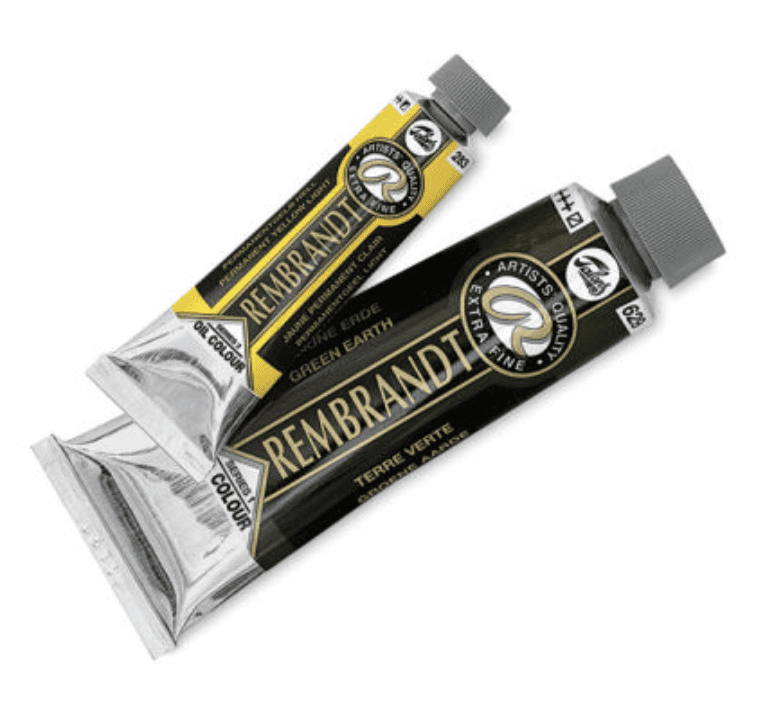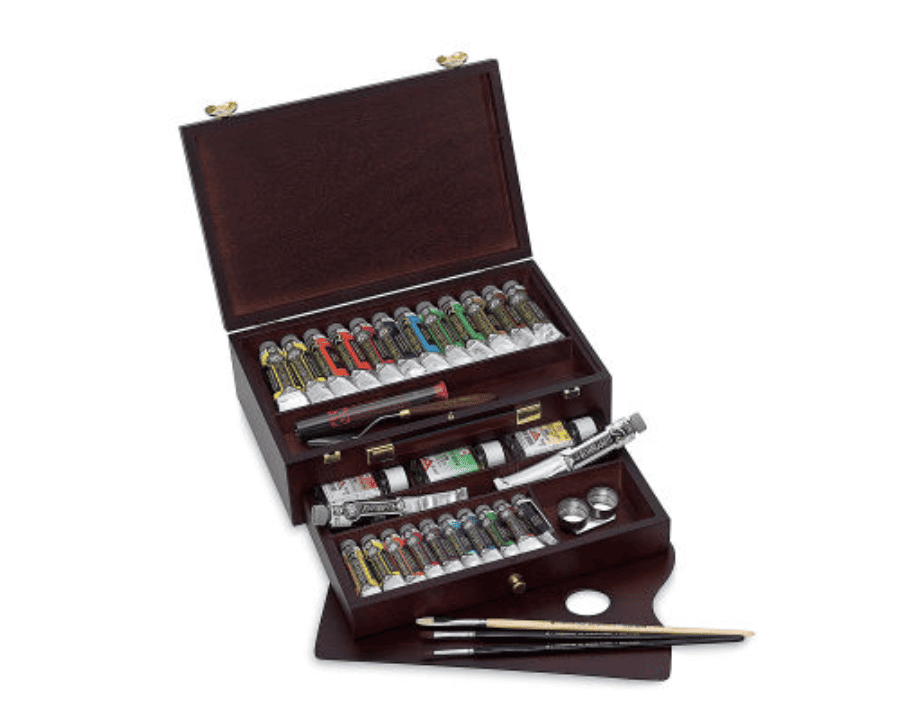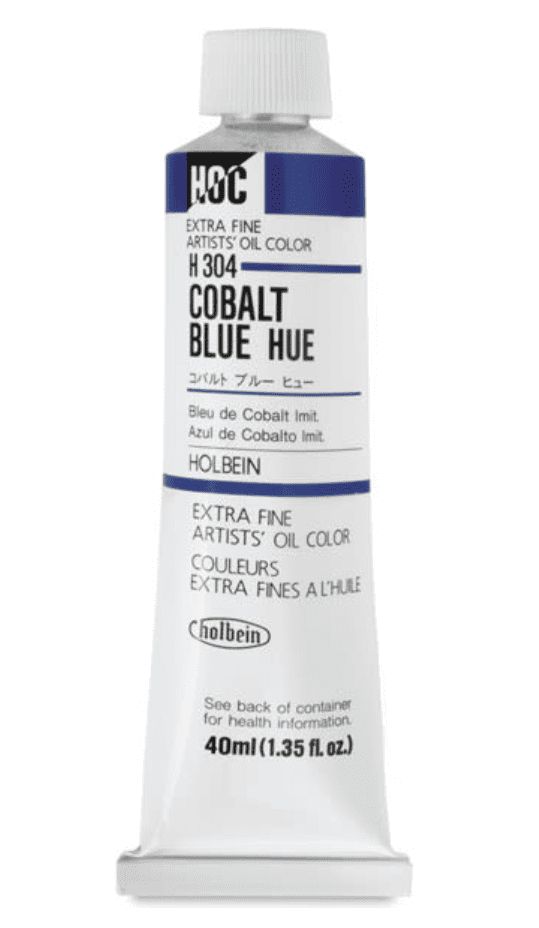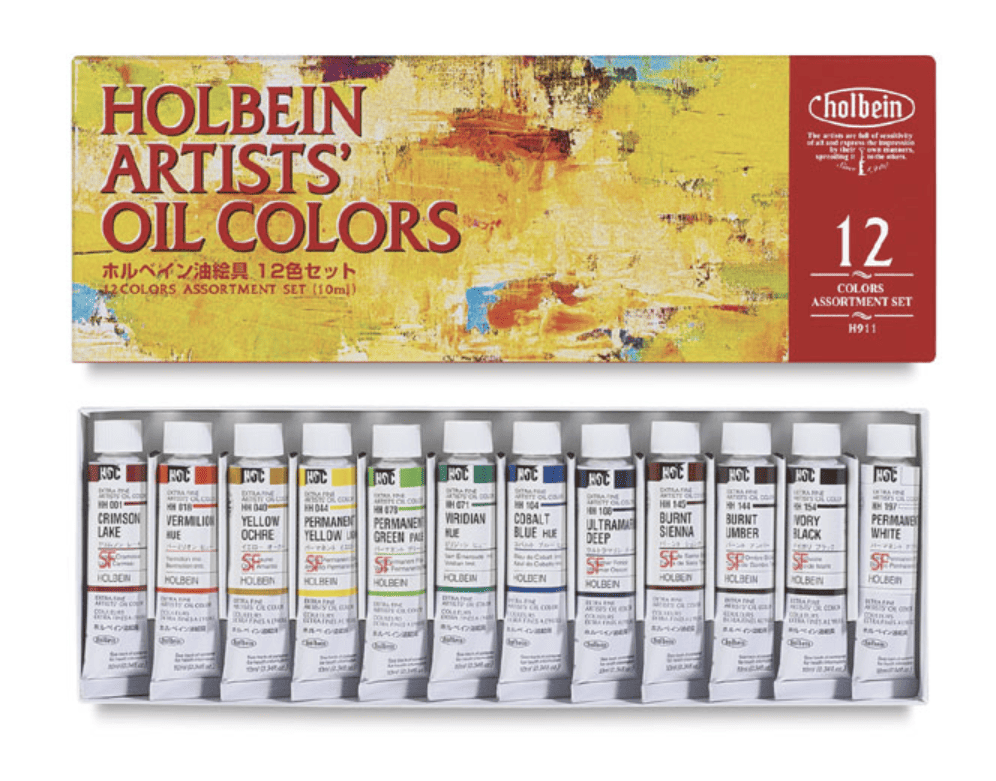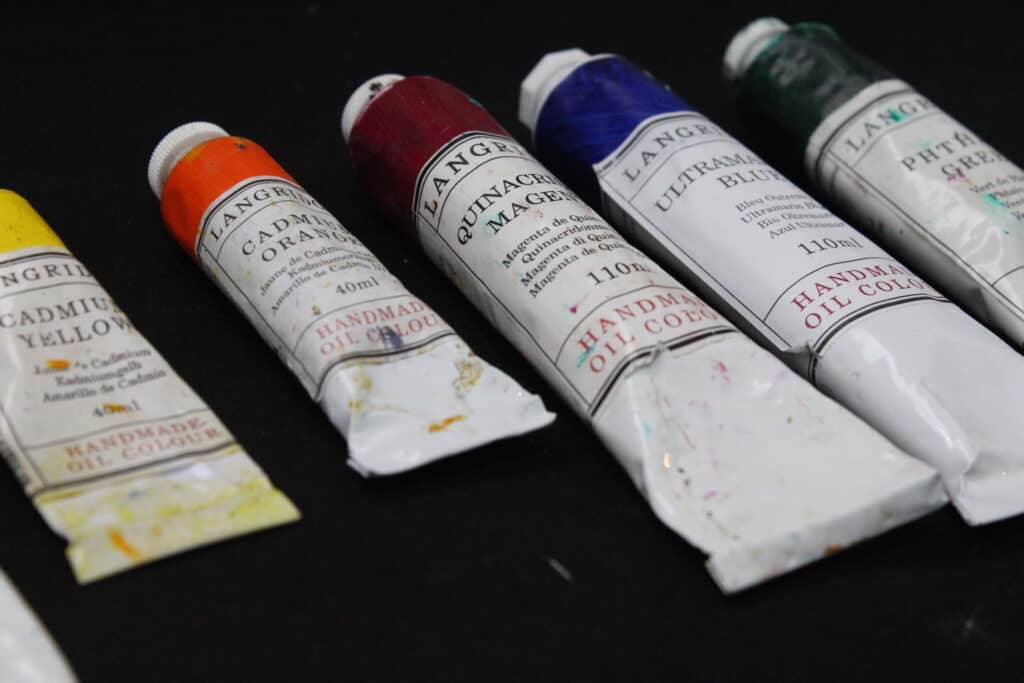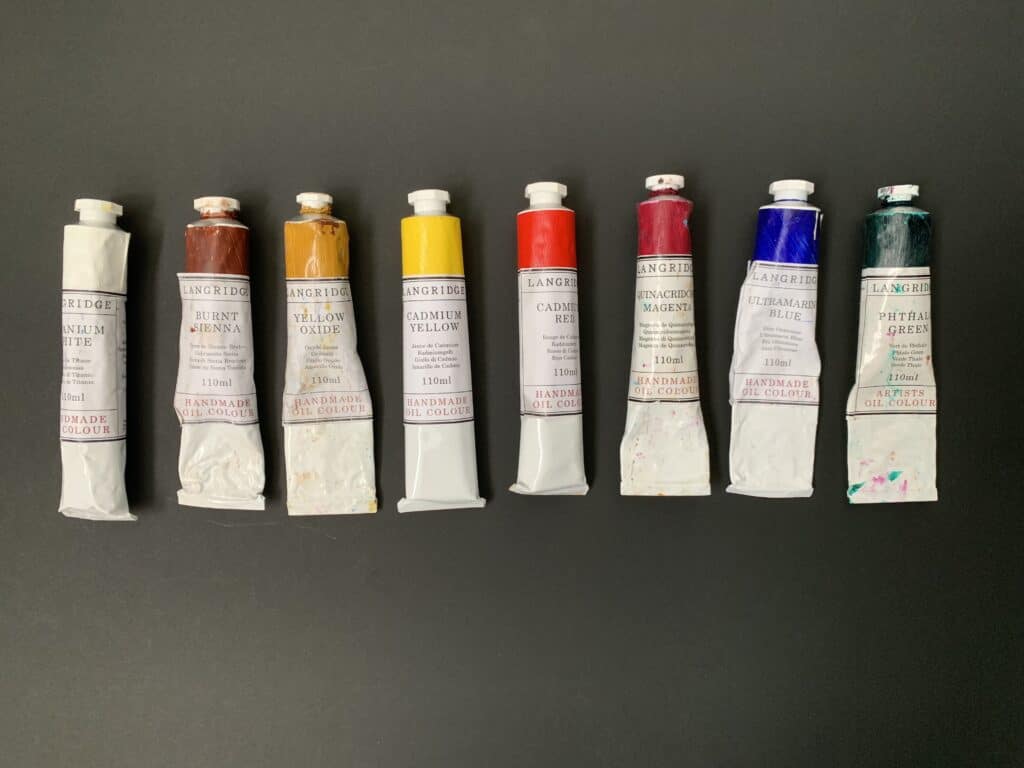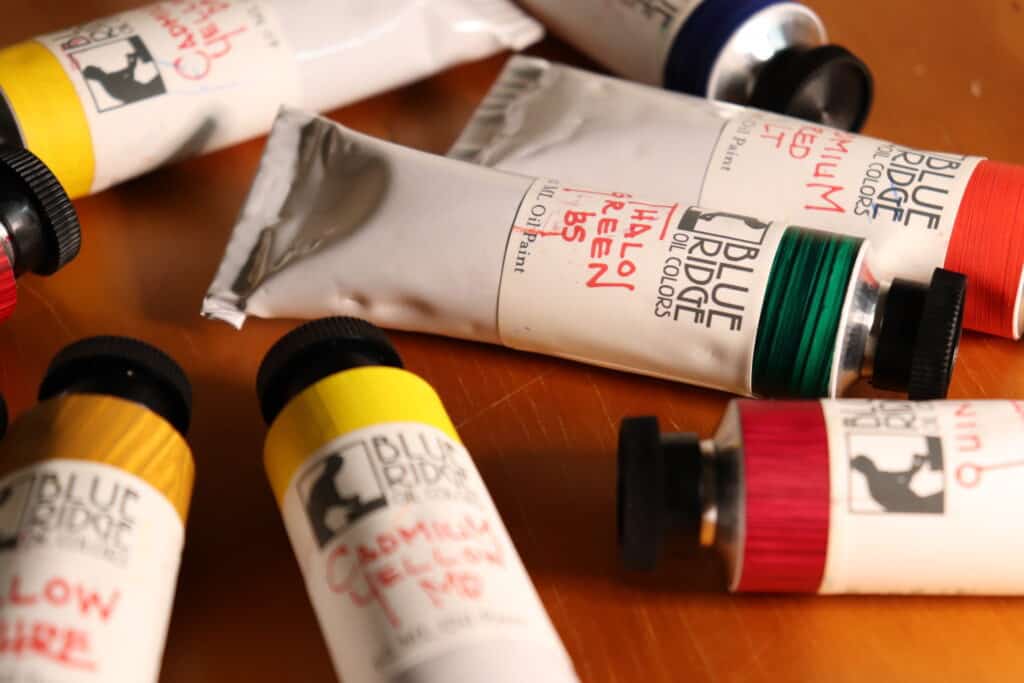
I absolutely love painting with oils, and oil painting has been a beloved medium for centuries, cherished for its versatility, vibrant colors, and longevity. Ever since I switched over to using oil paints back in 2004 I never looked back.
You may be a beginner looking to try oil paints for the first time or an experienced professional painter looking to try out a new paint brand, so this article is for you.
In this article, I present a handpicked selection of the best oil paint brands suitable for artists of all levels, from beginners to professionals. I have used some of these paint brands or know artists who use and recommend them.
Why should you listen to me? Well, I am an artist who especially loves to paint landscapes, and I have years of experience using oil paints and have tried many different brands.
My Top Picks
Blue Ridge Oil Colors

This is an all-around excellent artist-quality oil paint. Great for beginners and professional artists. This is the brand I currently use myself.
10 Best Oil Paints
Here is a curated list of some of the best oil paint brands. I have personally used some of these oil paint brands myself or know artists who use some of the brands listed below.
1. Blue Ridge Oil Colors
Blue Ridge Oil Colors is a reputable family-run brand that offers a diverse range of high-quality, affordable oil paints for artists. I personally use this brand of oil paint.
At Blue Ridge Oil Colors, you will discover a treasure trove of artist-grade paints designed to meet the needs of both beginners and professionals. This is an excellent oil paint for beginners.
Key Benefits
- Handmade paints
- Exceptional quality
- Meticulous attention to detail
- Paints have a rich, creamy consistency, allowing smooth application and effortless blending
- Focus on color vibrancy and permanence
- Retains its brilliance over time
- Easy-to-unscrew lids
- Good price point
- Ideal for beginners and professional artists
Price Range
$11.50 – $60
2. Winsor & Newton
Winsor & Newton is a highly respected and trusted brand among artists, known for its commitment to quality and innovation. Their oil paints are held in high regard by professionals and beginners alike.
In my opinion, Winsor and Newton are excellent oil paint and the water-mixable oils are good starter paint. When I switched from using acrylics to oils, I used Winsor and Newton water mixable oils and I was so impressed that I used them for many years. The clean-up is super easy, too as there is no need for toxic solvents.
Key Benefits
- Crafted using high-grade pigments
- Superior binders, ensuring vibrant colors and lightfastness.
- High-quality paints
- Vibrant colors
- Excellent lightfastness
- Water-mixable oils available formulated to provide oil paints’ traditional texture and performance while being water-mixable
- Ideal for beginners
Price Range
$5.77 – $68.39
3. Gamblin
Gamblin is a renowned brand in the world of oil paints, known for its dedication to producing high-quality products for artists.
The brand offers a wide range of colors, including traditional hues and unique shades, providing artists with a diverse palette to express their creativity. Additionally, Gamblin offers a variety of mediums, varnishes, and solvents designed to complement their oil paints and enhance their performance.
Key Benefits
- Crafted with meticulous attention to detail
- The finest pigments and binders used
- Exceptional color vibrancy and longevity
- Smooth consistency
- Excellent handling properties, allowing for effortless brushwork and blending
Price Range
$5.17 – 176.25
4. Old Holland
Old Holland oil paints have earned a well-deserved reputation as one of the finest and most prestigious brands available to artists. Since 1664, Old Holland has consistently produced exceptional oil paints that embody a deep commitment to quality and craftsmanship.
Old Holland oil paints assure artists that their artwork will maintain its vibrancy and beauty over time. Whilst I have not used Old Holland, I know of several artists who use this paint and swear by this brand.
Key Benefits
- High concentrations of the finest pigments
- Unparalleled color intensity and luminosity.
- Meticulous manufacturing process
- Dense and creamy paint consistency
- Excellent handling.
- Exceptional lightfastness and longevity
- Wide range of colors, including historical pigments and contemporary hues
Price Range
$14.74 – $465.75
5. Sennelier
Artists have long cherished Sennelier oil paints for their exceptional quality and rich history. With roots dating back to 1887, Sennelier has consistently produced artist-grade materials that meet the highest standards.
I love Sennelier oil paint, especially as this was the paint I used after I switched from using Winsor and Newton water mixable oils. The vibrancy and delicateness of the paint hit me when I first started using them, and I said to myself, wow! These paints are amazing. I felt that my artwork instantly improved after using this Sennelier oil paint.
Key Benefits
- Exceptional pigment concentration
- Vibrant colors
- Remarkable pigment concentration and lightfastness
- High-quality pigments meticulously ground to ensure optimal color intensity and purity.
- Wide range of colors, including both traditional and contemporary hues available
- Ideal for beginners and professional artists
Price Range
$9.98 – $130.98
6. Michael Harding
Michael Harding oil paints have become synonymous with uncompromising quality and exceptional performance among artists worldwide. Handcrafted with meticulous attention to detail, Michael Harding paints use only the finest pigments and traditional binders, resulting in vivid, lightfast colors that retain their brilliance over time.
Key Benefits
- Handcrafted
- The finest pigments and traditional binders used
- Vivid, lightfast colors that retain their brilliance over time.
- Each paint is carefully formulated to offer optimal texture
- Rich, buttery paint consistency
- Extensive range of colors, from classic to contemporary shades
- Ideal for beginners or seasoned professionals
Price Range
$12.20 – $702.00
7. M. Graham & Co.
M. Graham & Co. oil paints have gained a loyal following among artists for their exceptional quality and commitment to using the finest materials.
Founded in the late 1990s, this family-owned brand has quickly earned a reputation for producing artist-grade paints that deliver outstanding performance.
Key Benefits
- Made with high concentrations of pure pigments
- Vibrant and luminous colors that retain their brilliance over time.
- Paints are crafted with walnut oil as the binder.
- Unique and rich consistency enhances color saturation and provides a longer working time.
- Smooth and buttery paint texture
- Full range of colors, including traditional and contemporary shades
Price Range
$8.93 – $71.33
8. Rembrandt
Rembrandt oil paints have earned a well-deserved reputation as a trusted brand with a rich history in the art world. Named after the renowned Dutch master Rembrandt van Rijn, these oil paints embody the spirit of excellence and craftsmanship.
Key Benefits
- Superior quality and exceptional color range.
- Made from the finest pigments
- Excellent lightfastness, ensuring the longevity of your artwork.
- Smooth and buttery consistency
- Rich, vibrant colors
- Extensive range of colors available that encompasses traditional and modern hues
- Individual tubes and paint sets are available
Price Range
$12.71 – $1349.96
9. Holbein
Holbein Oil Paints has established itself as a trusted brand renowned for its exceptional quality and meticulous craftsmanship. With a rich history dating back to 1900, Holbein remains a preferred choice among artists worldwide.
With a commitment to excellence and innovation, Holbein continues to be a trusted brand for artists seeking top-quality materials that inspire creativity and produce stunning oil paintings.
Key Benefits
- Vibrant colors
- Superb lightfastness
- Outstanding pigmentation
- Finest pigments used combined with high-quality binders
- Unparalleled color intensity and permanence.
- Smooth buttery paint consistency
- Extensive range of colors, including traditional hues and unique shades
Price Range
$7.13 – $568.00
10. Langridge Handmade Oil Paints
Langridge Oil Paints is a renowned Australian brand that offers artists a truly exceptional painting experience.
With a strong emphasis on quality and craftsmanship, Langridge provides a wide selection of artist-grade oil paints that are meticulously handcrafted using traditional methods.
Key Benefits
- Each color is carefully formulated
- High concentrations of premium pigments
- Finely ground in high-quality binders to ensure optimal color intensity, lightfastness, and archival stability.
- Modern colors created with buttery paint consistency
- Extensive range of vibrant colors
- Ideal for beginners
Price Range
$13.95 – $264.55
Why Paint with Oils?
Oil paints offer many advantages that make them a popular choice among artists. First and foremost, oil paints have a slow drying time, allowing artists to work with the paint for extended periods.
This slow-drying property enables blending, layering, and reworking of colors, allowing artists to achieve subtle transitions and precise details. Additionally, oil paints offer unmatched richness and depth of color due to the high pigment concentration, resulting in vibrant and luminous oil paintings throughout.
When I first started using oil paints after many years of painting with acrylics, I instantly could see what the fuss was about. It was like, wow! The colors are so much more vibrant. I had all the time in the world to blend the colors, and I found that oils were nowhere near as difficult to paint with as I had imagined!
So now that you think you want to take the plunge and try oil painting, there are some essential things to consider before you buy.
When selecting oil paints, it is crucial to understand the difference between artists’ quality and student-quality oils.
Artists’ Quality Oils vs Student Quality Oils

Artist-grade oil paints are formulated explicitly with high-quality pigments and binders, resulting in superior color intensity, lightfastness, and longevity. These professional-grade oil paints are carefully manufactured to meet the needs of professional artists who require consistency and durability in their artwork.
On the other hand, student-quality oil paints are more affordable and aimed at beginners or artists on a budget. While they may contain similar colors to artists’ quality paints, they often employ lower-grade pigments and less binder, resulting in lower color intensity, weaker lightfastness, and less overall durability.
In short student-grade oil paints suck!
Not only do student paints suck, but they may also have uneven texture and handling properties, making achieving desired effects and long-lasting results challenging.
I had the misfortune of using student oil paints when I was a beginner back in the day, and it wasn’t a fun painting experience. The paints often have too much carrier, resulting in oil running down my palette and canvas. It wasn’t good!
When I eventually returned to using oil paints again, I made sure to use an artist’s quality oil paint.
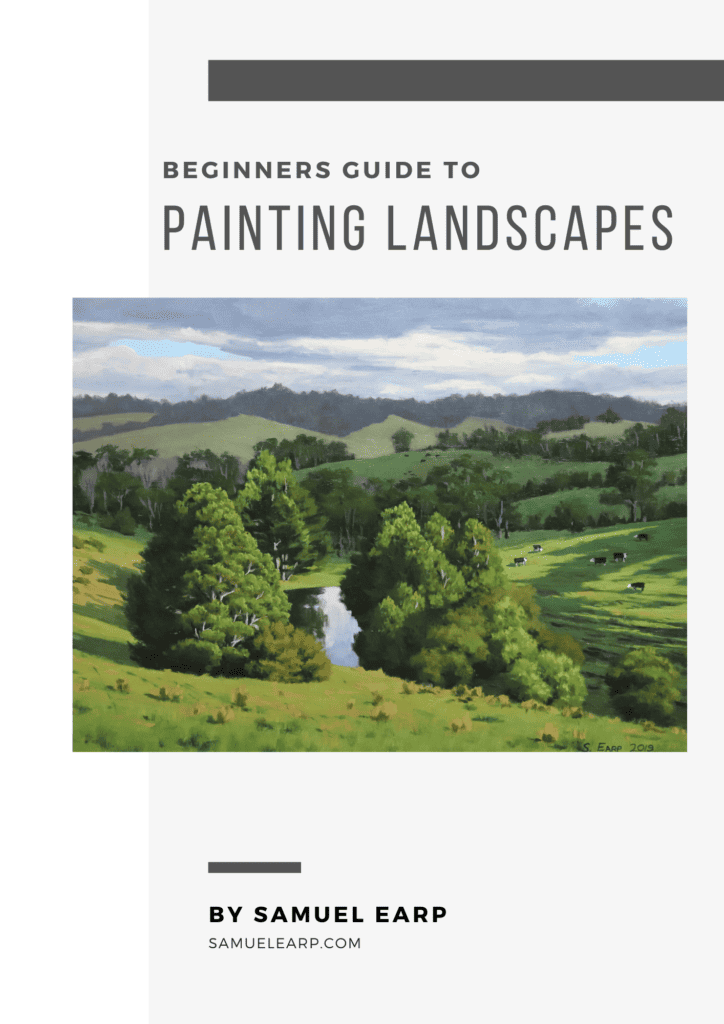
Why You Should Never Use Student Quality Oil Paints
Although student-quality oil paints can be enticing due to their lower price point, they are not as high quality and it is generally recommended to avoid using them. Here’s a list of why student oil paints suck!
1. Limited Color Range:
Student-quality paints often have a narrower range of colors than artists’ quality paints, limiting the artist’s ability to explore and create various tones and hues.
2. Fading and Color Shifts:
Student-quality paints are prone to fading and color shifts over time due to their lower pigment concentration and lower-quality binders. This can significantly affect the longevity and appearance of your artwork.
3. Less Mixing Versatility:
Due to the lower pigment load, student-quality paints may not mix as smoothly or easily as artist-quality paints. Achieving accurate color mixing and consistent results can be challenging.
4. Limited Texture and Handling:
The texture and consistency of student-quality paints may vary, making it difficult to achieve desired effects such as impasto or smooth glazes. This can limit your artistic expression and hinder your ability to create specific techniques.
5. Limited Professional Growth:
By investing in artists’ quality paints, you equip yourself with superior materials to fully explore your artistic potential. Using student-quality paints may hinder your progress and limit the quality of your work.
There is no doubt that student-quality oil paints are more affordable. Still, through my many years of oil painting and using artists’ quality oils, I have found the more expensive colors tend to last much longer.
The colors I use the most in oil painting, such as titanium white, ultramarine blue, burnt sienna, and yellow ochre, are usually much less expensive than cadmium or cobalt colors.
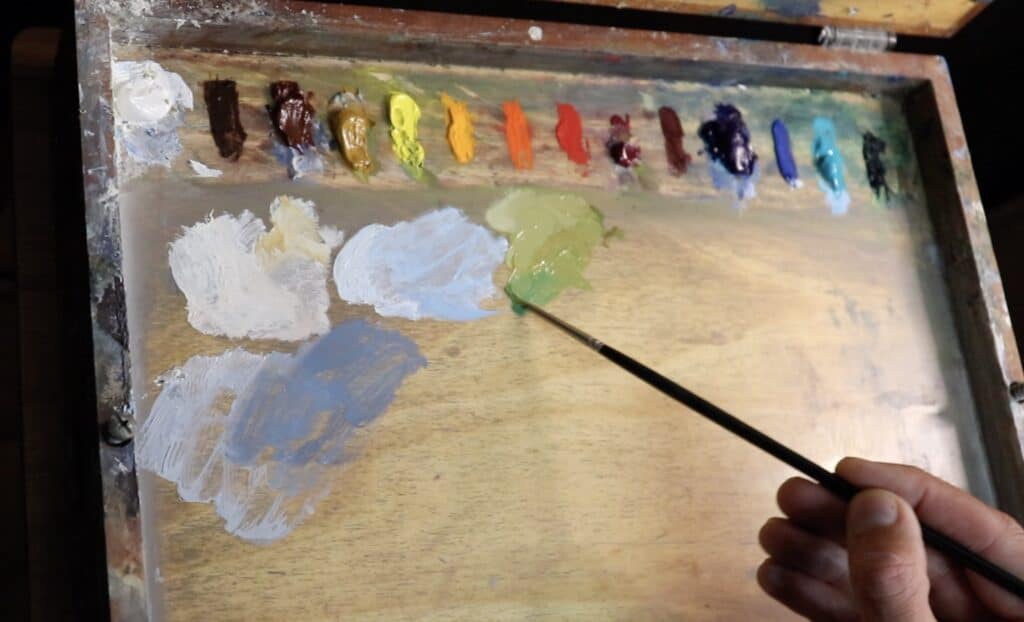
Why Beginner Artists Should Use Artist Quality Oils and Not Student Grade Oils
As a beginner artist, opting for student-quality oil paints may be tempting due to their lower price; however, they are a bit of a false economy due to their lower quality. However, from the start, investing in artist-quality oils can significantly impact your artistic journey, and your painting experience will be much more joyful.
Artist-quality oil paints are specifically formulated with higher-grade rich pigments and binders, offering superior color intensity, lightfastness, and longevity.
Another reason for using artist-quality oils is that it allows beginners to experience the true potential of oil painting. These professional-grade oil paints offer a broader range of colors, allowing you to explore and express your creativity with a more comprehensive range of hues. They also provide better mixing capabilities, enabling accurate color blends and variations.
Furthermore, using artist-quality oils sets a solid foundation for your artistic growth, so in my opinion, you should start with a good quality oil paint from the get-go.
Investing in artist-quality oils demonstrates a commitment to your artistic development and the quality of your work. It sets a standard of excellence, pushing you to strive for better results and elevating your skills.
While student-quality oils may be more affordable, their limitations in color range, lightfastness, and durability can hinder your progress as an artist.

Types of Oil in Oil Painting
In oil painting, the type of oil used as a binder in the paint greatly influences the handling, drying time, and overall characteristics of the artwork. Here are some commonly used types of oil in oil painting:
1. Linseed Oil
Linseed oil is one of the most widely used oils in the oil painting world. It is derived from the flaxseed plant and has been used for centuries due to its excellent drying properties. Linseed oil dries relatively faster than other oils, producing a durable and flexible paint film. It enhances color saturation and gives a glossy finish to the painting.
2. Walnut Oil
Walnut oil is a popular alternative to linseed oil, particularly for artists who prefer a slower drying time. It has a rich, clear color and offers a longer open working time, allowing for extended blending and manipulation of the paint. Walnut oil also tends to resist yellowing over time, making it a good choice for artists concerned about the aging of their artwork.
3. Poppy Seed Oil
Poppy seed oil is a lighter oil that dries relatively slowly compared to linseed oil. It produces a pale, transparent film and is ideal for thin glazes and delicate layering techniques. Poppy seed oil also has a smooth consistency, which can be beneficial for achieving subtle brushwork and smooth transitions.
4. Safflower Oil
Safflower oil is a pale, low-yellowing oil that dries more slowly than linseed oil. It has a similar consistency to poppy seed oil. It is often used as an alternative for artists sensitive to linseed oil’s yellowing effects. Safflower oil suits artists who desire a longer working time and prefer greater control over the drying process.
5. Stand Oil
Stand oil is a thick, honey-like form of linseed oil that has been heated. It has a higher viscosity and provides a glossy finish with increased transparency. Stand oil is often used as a medium or glazing medium to enhance the paint flow, increase color intensity, and impart a lustrous quality to the finished artwork.
These are just a few examples of the types of oil used in oil painting. Each oil has its unique properties, and artists often experiment with different combinations and ratios to achieve desired effects. Understanding the characteristics of various oils can help artists choose the suitable medium for their artistic goals, allowing them to explore and create confidently.
Choosing an Oil Paint Brand
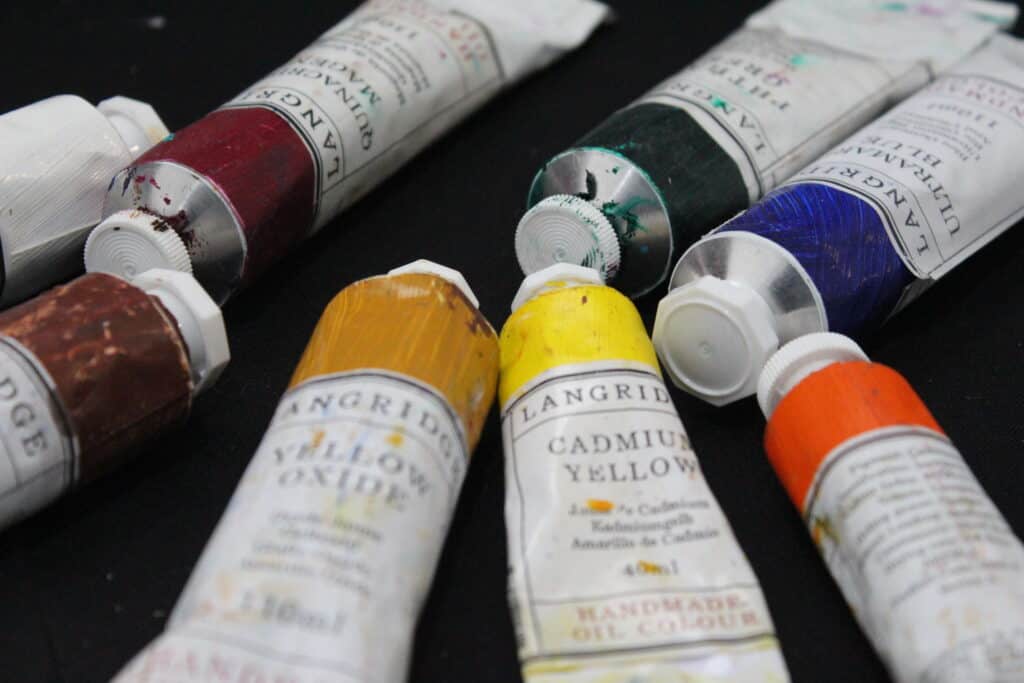
Choosing an oil paint brand is an important decision for you as an artist or a beginner, as it will directly impact the quality and outcome of your artwork. When selecting an oil paint brand, several factors should be considered.
First and foremost, look for brands that offer artist-grade paints rather than the student-quality options we discussed previously.
Established brands with a long-standing presence often have a proven record of producing reliable and consistent paints. Exploring the brand’s color range and availability of unique or specialized hues that align with your artistic techniques is also helpful.
Price is a big consideration when choosing a paint brand; undoubtedly, some artist’s grade oil paints are pretty darned expensive. However, you can buy some decent paints without breaking the bank.
In the following section, I recommend eight basic colors that I use, and half of the oil paints on this list are relatively inexpensive.
One last thing when choosing an oil paint brand is to stick to one brand rather than having a load of oil paints from several different brands. When you use one brand of paint, you know that they will all combine well with each other.
The 8 Basic Oil Painting Colors For Your Palette
The following list of colors is what I personally use for painting landscapes. I prefer to use a more limited palette as I have found it easier and less confusing and my paintings have much better color harmony within them.
By using fewer colors, you are much more likely to be using similar colors throughout your painting, which means your whole painting style will be more harmonious and read well to your viewer.
- Titanium white
- Burnt sienna
- Yellow ochre
- Cadmium yellow
- Cadmium red
- Alizarin crimson
- Ultramarine blue
- Phthalo green
Conclusion
Investing in an artist’s quality oil paints is wise for any artist seeking to create vibrant, long-lasting, and professional artwork.
The brands listed above, including Winsor & Newton, Gamblin, Old Holland, Sennelier, Michael Harding, M. Graham & Co., Rembrandt, and Holbein, offer exceptional choices that guarantee the highest quality pigments and binders.
By choosing artist-quality oil paints, beginners can confidently embark on their artistic journey, using materials that provide exceptional quality, vibrant colors, and long-lasting artwork. Remember, the paint you use is not just a tool; it is an essential component in expressing your artistic vision.
Bookmark this post on Pinterest!
